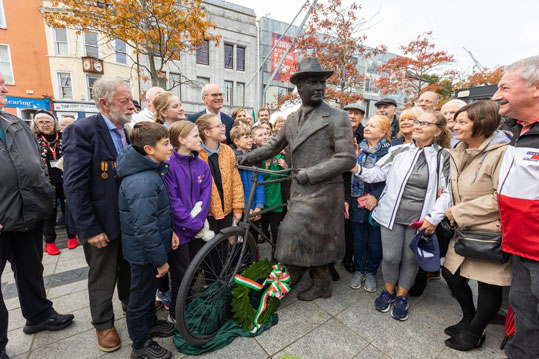BY DONAL FALLON
WOLFE TONE REMEMBERED
Were it not for the infectious enthusiasm of William Atkins—an American descendant of Theobald Wolfe Tone and history enthusiast—perhaps the 225th anniversary of Tone’s death would have gone largely unmarked in Belfast and Dublin, two cities with which Tone’s life is forever connected. Over three days, the ‘Wolfe Tone 225’ event hosted talks, round tables and even musical performances. Speakers included Tom Bartlett, James Smyth, Fergus Whelan and Marianne Elliot. In just a few short months, Atkins succeeded in organising an event that brought full houses to both Dublin’s Tailor’s Hall (site of the 1792 Catholic Conventions, a.k.a. ‘Black Lane Parliament’) and Belfast’s Clifton House. Readers will be glad to hear that the sessions are now available to enjoy on YouTube, thanks to high-quality live-streaming on the day (search for ‘Wolfe Tone 225’)

LOOK BACK TO LOOK FORWARD
Congratulations to the organisers of the Look Back to Look Forward exhibition, exploring the contributions of Irish emigrants to British society over the past 50 years. Visiting London, Liverpool, Birmingham and Leeds in October and November last year, the oral history exhibition recorded firsthand testimonies from over 100 people on issues including labour history and political activism amongst the Irish in Britain. Having trained more than 50 volunteers with the skill sets to conduct oral history interviews, the exhibition notes that ‘many Irish immigrants who settled in Britain since 1973 are now elderly, risking the loss of their migration memories. We share their voices to ensure their legacies endure.’ Plans are in discussion to bring the exhibition to Dublin. An online version can be viewed at www.exhibitions.irishinbritain.org/lookback/.
GOOD VIBRATIONS AND TEENAGE KICKS
Belfast’s Great Victoria Street has been in need of regeneration of late, but a large-scale art tribute to Terri Hooley at the site of his Good Vibrations record shop will certainly bring visitors to the area. It is the first of six murals planned for the street, working with leading street artists from across Northern Ireland. Founder of the record shop and label that operated under the same name, Hooley is best recalled for releasing The Undertones’ breakthrough single ‘Teenage Kicks’. The track impressed legendary DJ John Peel enough that he played it twice in a row, now considered a defining moment of punk history. Speaking to the Belfast Telegraph, Hooley recalled how ‘Good Vibrations was more than a record shop and music label. It was an oasis amid the confusion and chaos at the time. It brought people from different communities together to share in a single passion, and for many represented a sense of hope for the future.’ Separately, a new mural in Derry by artist Karl Porter honours The Undertones.
REMEMBERING MONICE DE WICHFELD
The latest Ulster History Circle blue plaque has been unveiled in Derrylin, Co. Fermanagh. Monice de Wichfeld (née Massy-Beresford) played a significant role in the Danish resistance movement during the Second World War but had earlier been involved with the Ulster Volunteer Force, participating in the 1914 Larne gunrunning operation. Her marriage to Dutch aristocrat Jørgen de Wichfeld transformed the course of her life. In a 2014 ‘An Irishman’s Diary’ column for the Irish Times, historian Felix M. Larkin noted that ‘She began by assisting in the distribution of underground publications but was soon giving shelter to fugitives and allowing her lands to be used for parachute drops of supplies’. She died in Saxony’s Waldheim Prison in February 1945. Chris Spurr of the Ulster History Circle noted that ‘There is a memorial to her in her beloved Engestofte Church in Denmark. In Derrylin her name is in the parish church on the roll of honour of those who gave their lives in World War II.’
WICKLOW GAOL COMRADES: A CIVIL WAR AUTOGRAPH BOOK
Historian Aaron Ó Maonaigh has demonstrated how a single item can be transformed with the publication and exhibition Wicklow Gaol Comrades, constructed around a 1923 Civil War autograph book donated to Wexford County Archives many years ago. Such autograph books are often loaded with sketches, poems, laments and jokes. Tracing the families of the men who signed one such book has led to an exhibition, publication and video, which will travel through Wicklow public libraries in the months ahead. Emer O’Gorman, chief executive of Wicklow County Council, noted that ‘this little item—measuring just five inches by four—is brimming with salutations, sketches and poetry, evoking the personalities, humour and resilience of the men imprisoned in this very building 100 years ago’.
See www.heritage.wicklowheritage.org/.
THE BICYCLE WAR
Recently we noted the unveiling of a new plaque in London’s Islington to Michael Collins. Not to be outdone, Cork has unveiled a new statue to the political leader on Grand Parade. Unusually, the statue was funded through a crowd-funding scheme. What makes sculptor Kevin Holland’s life-size statue of Collins unique is the presence of a Pierce bicycle. Along with Lucania in Dublin, Pierce was a favoured brand of Irish nationalists in revolutionary times. The new statue recalls an entertaining 2019 article by historian Barry Sheppard (see pp 42–4), available on The Irish Story website, in which he charted the importance of the bicycle in revolutionary Ireland. Sheppard writes that ‘During the last months of conflict, before the truce of 1921, British intelligence ordered raiding parties on 10 May 1921 to seize all bicycles in their areas when engaging with Volunteers … This has been termed the “Bicycle War” by historian Joseph McKenna.’
See www.theirishstory.com/2019/11/07/recycling-history-the-bicycle-and-protest-in-ireland/.
